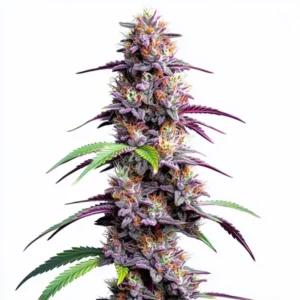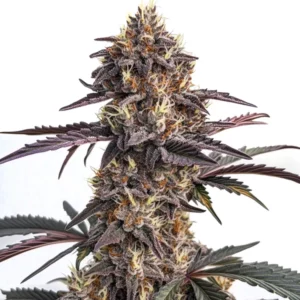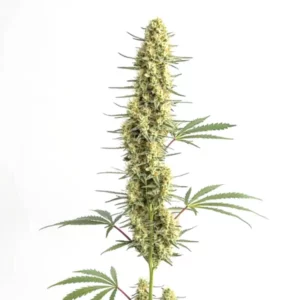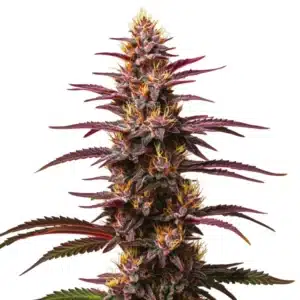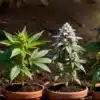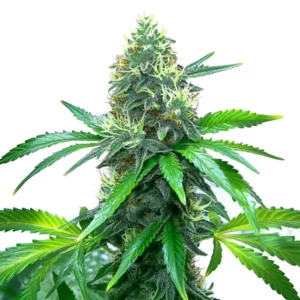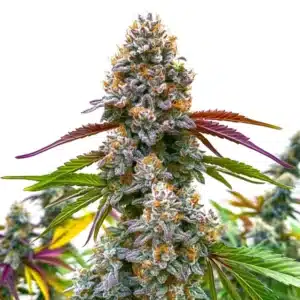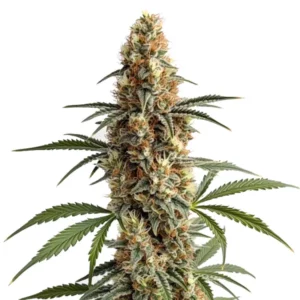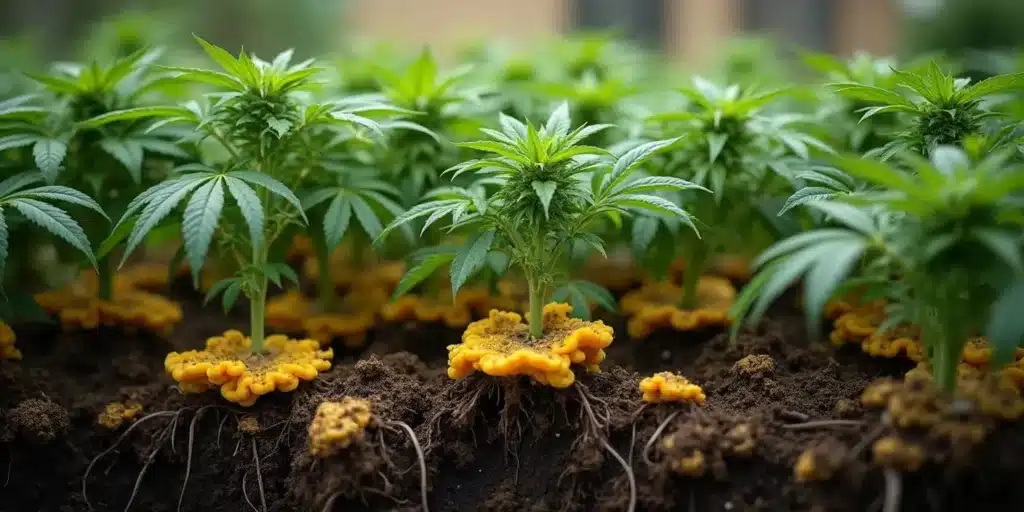
Yellow Fungus on Cannabis Roots
Yellow fungus on cannabis roots can be a real headache for growers. This sneaky problem, also known as root rot, thrives in overly moist environments and can quickly derail your gardening efforts if not managed properly. Think of your cannabis roots as the lifeline of your plants. When yellow fungus sets in, it’s like a clogged artery, preventing nutrients and water from reaching their destination.
Recognizing the symptoms early and knowing how to treat them can save your crop. It’s all about being proactive and paying attention to the little details.
Recommended Strains
Permanent Marker
|
|
THC | 32% - 34% (High) |
|
|
Type | Feminized |
|
|
Yield | High |
|
|
Phenotype | 50% Indica / 50% Sativa |
Permanent Marker Auto
|
|
THC | 32% - 34% (High) |
|
|
Type | Autoflowering |
|
|
Yield | Medium |
|
|
Phenotype | 50% Indica / 50% Sativa |
Causes of Yellow Fungus on Cannabis Roots
The causes of yellow fungus are often related to environmental conditions. Overwatering is one of the biggest culprits. When waterlogged, the roots can’t breathe, creating a perfect breeding ground for fungus. Poor drainage is another factor.
Temperature and humidity also play significant roles. The temperature of the pots and the soil within them is a very important factor for the appearance of root rot. A combination of heat and excess water is a sure-fire recipe for fungus. For outdoor plants, it’s crucial to watch that direct sun doesn’t hit the pots all day, as this can raise the soil temperature to a point where the roots are essentially ‘cooked’.
Beyond overwatering and poor drainage, soil composition is another factor. When soil is too compact, it restricts airflow. The use of contaminated tools or pots can also introduce yellow fungus.
Identifying Symptoms of Yellow Fungus
Symptoms aren’t always obvious. Look for signs like yellowing leaves, which might seem like a nutrient deficiency at first. Wilting or drooping plants can also indicate root problems. Another symptom is a musty smell coming from the soil. Healthy roots should smell earthy, not stale or sour. You might also notice that your plants are not absorbing nutrients effectively, leading to various deficiencies despite adequate feeding.
Promos & Deals
Preventing Yellow Fungus on Cannabis Roots
Preventing yellow fungus is easier than dealing with an active outbreak. Start with your watering routine and allow the topsoil to dry out between waterings.
Good drainage is another preventative measure. Use pots with drainage holes and consider adding perlite to your soil mix. The type of pot you use also matters, especially if your plants will be in the sun. It is better to use white or clay pots instead of black plastic ones. White or clay pots absorb less heat, which helps keep the root zone at a cooler, safer temperature and prevents the conditions that favor fungus.
Applying a layer of mulch to the topsoil is another excellent preventative measure. Mulch protects the roots from temperature extremes, helps the soil retain moisture so you don’t have to water as often, and prevents the top layer from becoming a breeding ground for fungus.
Maintaining consistent temperature and humidity levels is crucial. Invest in a good thermometer and hygrometer. If you’re growing indoors, consider using fans and dehumidifiers.

How to Treat Yellow Fungus on Cannabis Roots
If yellow fungus is already affecting your plants, don’t panic. The first step is to stop watering until the soil dries out. Consider using a fungicide designed for root problems; organic options are available.
Another treatment method that some growers use is to adjust the pH of the irrigation water. If you detect fungus on the roots, lowering the pH of your water to around 5.5 can help make the root zone less hospitable to the pathogens causing the rot.
In addition to these treatments, improving the environmental conditions can aid recovery. Ensure your grow room is well-ventilated and that the temperature and humidity are within the ideal range.
Repotting and Root Pruning
In severe cases, you might need to repot your plants. Remove as much of the infected soil as possible and trim away any damaged roots. This process can be stressful for the plant, so it should be a last resort. When repotting, use fresh soil and a clean pot with adequate drainage. After repotting, monitor the plant’s recovery closely.
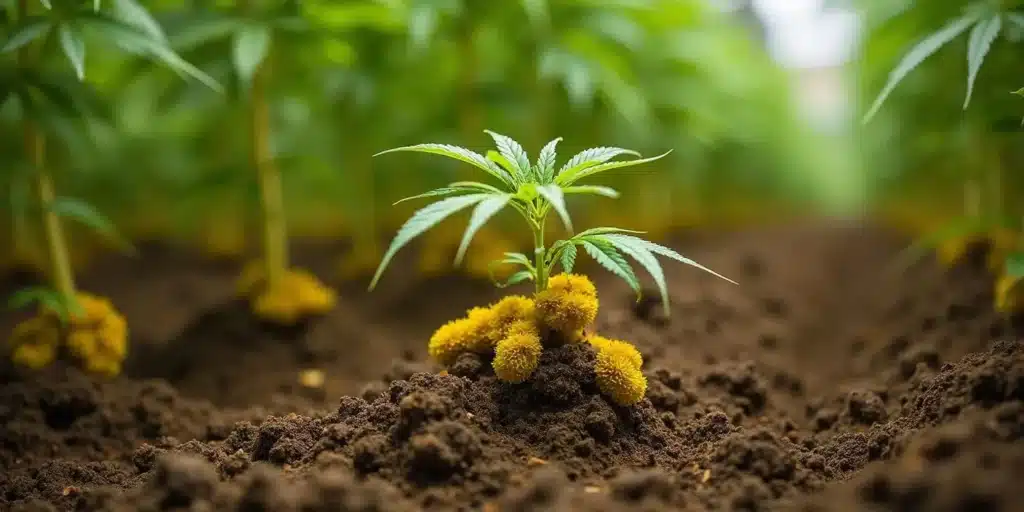
FAQ Section
What are the common signs of yellow fungus on cannabis roots?
Common signs include yellowing leaves, wilting, and a musty smell from the soil. These symptoms might be mistaken for other issues, so it’s important to check the roots directly. Healthy roots are white and firm, while affected roots appear brown and mushy.
Another sign to watch for is stunted growth. If your plants are not growing as expected, it may be due to root problems. Regularly inspecting your plants and knowing what to look for can help you catch yellow fungus early.
Pay attention to any unexpected changes in your plant’s appearance or vigor. Discoloration or unusual patterns on the leaves can often be traced back to issues with the roots. Understanding these symptoms can help in diagnosing yellow fungus on cannabis roots accurately.
Additionally, keep an eye on your plants’ nutrient uptake. If your feeding routine doesn’t seem to be having the expected effect, it could indicate that the roots are compromised by yellow fungus. Regular assessments can keep your plants healthy and productive.
How can I prevent yellow fungus from affecting my cannabis root health?
To prevent yellow fungus, focus on proper watering techniques and ensure good drainage. Allow the topsoil to dry out between waterings and use pots with drainage holes. Consider adding perlite to your soil mix to improve aeration.
Maintaining a consistent environment is also crucial. Keep temperature and humidity levels in check, and use fans or dehumidifiers if necessary. Choosing resistant strains like those from Blimburn Seeds can provide an extra layer of protection.
Implementing a regular cleaning schedule for your growing area can also help in preventing yellow fungus on cannabis roots. Removing debris and sanitizing surfaces reduces the risk of fungal spores settling into your soil.
Incorporating beneficial fungi and bacteria into your soil can enhance root health and resilience. These organisms can help outcompete harmful fungi, reducing the likelihood of yellow fungus taking hold in your garden.
Why is yellow fungus more common in certain growing conditions?
Yellow fungus thrives in overly moist and humid environments. Overwatering and poor drainage create ideal conditions for its growth. Temperature fluctuations can also stress plants, making them more susceptible to root problems.
Managing your growing environment effectively can reduce the risk of yellow fungus. Consistency is key, so monitoring your setup regularly will help you maintain healthy conditions for your cannabis plants.
Soil composition also plays a role in yellow fungus proliferation. Dense or compacted soil limits airflow, creating an environment where fungal growth is more likely to occur. Ensuring your soil is well-aerated can mitigate these risks.
Changes in the seasons can also influence the growing conditions. As temperatures and humidity levels shift, adjusting your care routine accordingly can prevent yellow fungus on cannabis roots from becoming a problem.
Are there any cannabis strains particularly resistant to yellow fungus?
Yes, some strains are more resilient against root problems. For example, Grizzly Purple Kush, OG Kush, and Critical Daddy Purple from Blimburn Seeds are known for their hardiness. These strains can be a good choice if you’re worried about yellow fungus.
Choosing a resistant strain can give you peace of mind and reduce the chances of encountering root issues. Always consider strain characteristics when planning your grow.
Researching the genetics of each strain can provide insights into their resistance to yellow fungus on cannabis roots. Some strains have been specifically bred for resilience, making them ideal for growers looking to minimize root issues.
Consulting with other growers or seed banks can provide valuable information on which strains are best suited to your growing conditions. This community knowledge can be incredibly useful in selecting the right strain for your needs.
What steps should I take if I find yellow fungus on my cannabis roots?
If you discover yellow fungus, start by letting the soil dry out to slow its spread. Consider using a fungicide specifically designed for root problems. Follow the product instructions for the best results.
In severe cases, repotting might be necessary. Remove infected soil and trim damaged roots before placing your plant in fresh soil. Monitor your plant closely after treatment to ensure recovery and continued health.
After addressing the immediate problem, take steps to improve your overall growing environment. This might include adjusting your watering routine, enhancing air circulation, or modifying your soil composition to prevent future issues.
Documenting your treatment process can be helpful for future reference. By noting what worked and what didn’t, you can refine your approach in managing yellow fungus on cannabis roots and improve your success rate in future grows.




